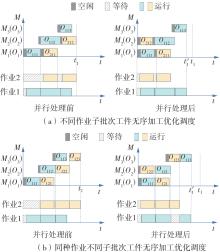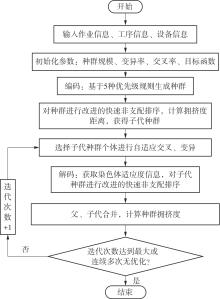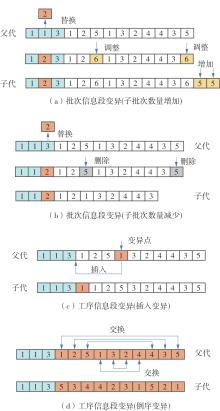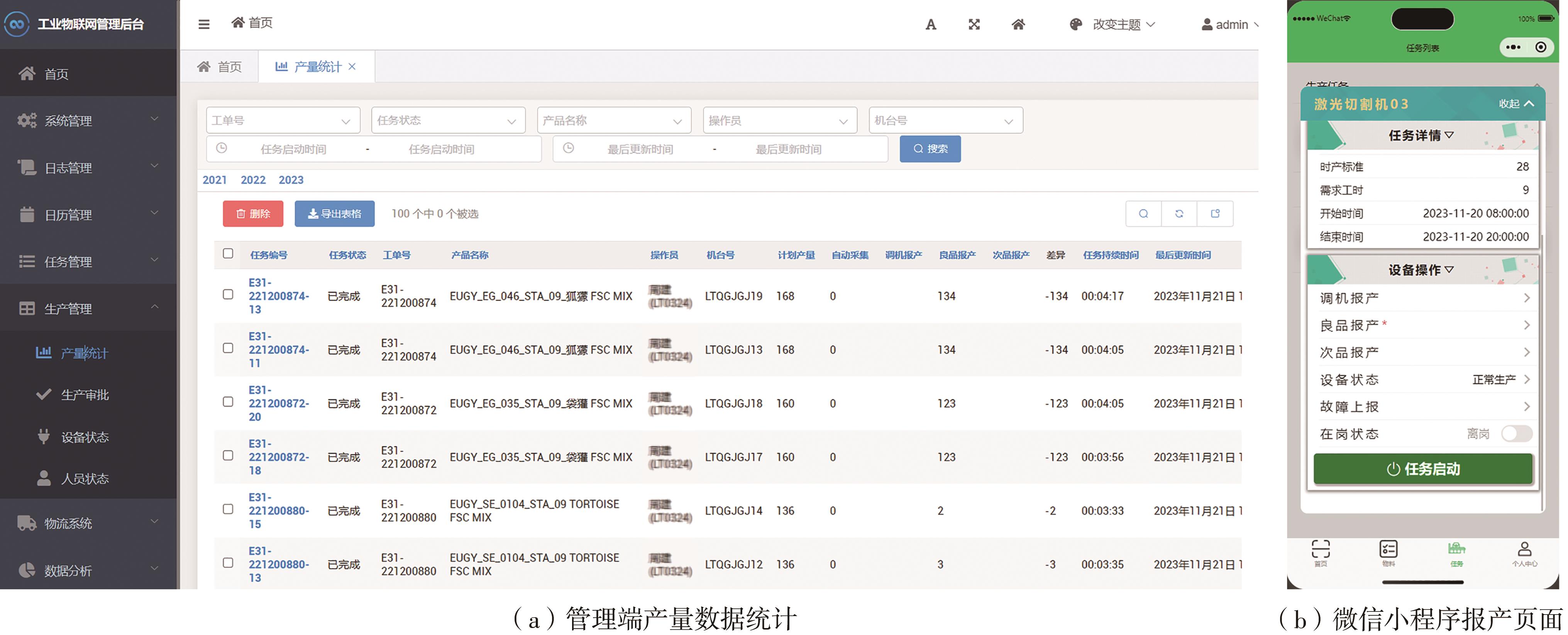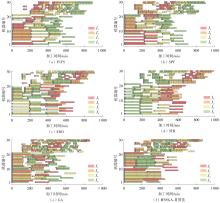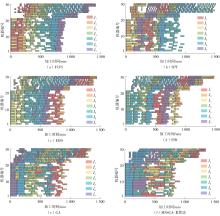| 1 |
YI H, QU T, ZHANG K,et al .Production logistics in industry 3.x:bibliometric analysis,frontier case study,and future directions[J].Systems,2023,11(7):371/1-30.
|
| 2 |
LI M, LI M, GUO D,et al .Real-time data-driven out-of-order synchronization for production and intralogistics in multiresource-constrained assembly systems[J].IEEE Transactions on Systems,Man,and Cybernetics:Systems,2023,53(12):7513-7525.
|
| 3 |
BRUCKER P, SCHLIE R .Job-shop scheduling with multi-purpose machines[J].Computing,1990,45:369-375.
|
| 4 |
徐本柱,费晓璐,章兴玲 .柔性作业车间批量划分与并行调度优化[J].计算机集成制造系统,2016,22(8):1953-1964.
|
|
XU Benzhu, FEI Xiaolu, ZHANG Xingling .Batch division and parallel scheduling optimization of flexible job shop[J].Computer Integrated Manufacturing System,2016,22(8):1953-1964.
|
| 5 |
ZHAO B, GAO J, CHEN K,et al .Two-generation Pareto ant colony algorithm for multi-objective job shop scheduling problem with alternative process plans and unrelated parallel machines[J].Journal of Intelligent Manufacturing,2018,29(1):93-108.
|
| 6 |
JAMRUS T, CHIEN C F,GEN M,et al .Hybrid particle swarm optimization combined with genetic operators for flexible job-shop scheduling under uncertain processing time for semiconductor manufacturing[J].IEEE Transactions on Semiconductor Manufacturing,2017,31(1):32-41.
|
| 7 |
SUN K, ZHENG D, SONG H,et al .Hybrid genetic algorithm with variable neighborhood search for flexible job shop scheduling problem in a machining system[J].Expert Systems with Applications,2023,215:119359/1-18.
|
| 8 |
LI Y, CHEN X, AN Y,et al .Integrating machine layout,transporter allocation and worker assignment into job-shop scheduling solved by an improved non-dominated sorting genetic algorithm[J].Computers & Industrial Engineering,2023,179:109169/1-19.
|
| 9 |
ZHANG F, MEI Y, NGUYEN S,et al .Multitask multiobjective genetic programming for automated scheduling heuristic learning in dynamic flexible job-shop scheduling[J].IEEE Transactions on Cybernetics,2023,53(7):4473-4486.
|
| 10 |
BRAUNE R, BENDA F, DOERNER K F,et al .A genetic programming learning approach to generate dispatching rules for flexible shop scheduling problems[J].International Journal of Production Economics,2022,243:108342/1-13.
|
| 11 |
SONG W, CHEN X, LI Q,et al .Flexible job-shop scheduling via graph neural network and deep reinforcement learning[J].IEEE Transactions on Industrial Informatics,2022,19(2):1600-1610.
|
| 12 |
张凯,毕利,焦小刚 .集成强化学习算法的柔性作业车间调度问题研究[J].中国机械工程,2023,34(2):201-207.
|
|
ZHANG Kai, BI Li, JIAO Xiaogang .Research on flexible job-shop scheduling problems with integrated reinforcement learning algorithm[J].China Mechanical Engineering,2023,34(2):201-207.
|
| 13 |
LI Y, WANG A, ZHANG S .A batch scheduling technique of flexible job-shop based on improved genetic algorithm[C]∥ Proceedings of 2022 IEEE International Conference on Mechatronics and Automation.Guilin:IEEE,2022:1463-1467.
|
| 14 |
刘雪红,段程,王磊 .基于改进候鸟算法的柔性作业车间分批调度问题[J].计算机集成制造系统,2021,27(11):3185-3195.
|
|
LIU Xuehong, DUAN Cheng, WANG Lei .Flexible job shop scheduling with lot streaming based on improved migrating birds optimizetion algorithm[J].Computer Integrated Manufacturing System,2021,27(11):3185-3195.
|
| 15 |
闫富乾,陈浩杰,丁国富,等 .求解柔性分批调度问题的双层搜索框架入侵杂草算法[J].计算机集成制造系统,2023,29(2):556-567.
|
|
YAN Fuqian, CHEN Haojie, DING Guofu,et al . Improved invasive weed algorithm based on double layer search framework for flexible batch scheduling problem[J].Computer Integrated Manufacturing System,2023,29(2):556-567.
|
| 16 |
DEB K, PRATAP A, AGARWAL S,et al .A fast and elitist multiobjective genetic algorithm:NSGA-Ⅱ[J].IEEE Transactions on Evolutionary Computation,2002,6(2):182-197.
|
| 17 |
李树勋,胡迎港,李成,等 .基于代理模型的轴流式调节阀阀体型线优化[J].华南理工大学学报(自然科学版),2023,51(3):41-52.
|
|
LI Shuxun, HU Yinggang, LI Cheng,et al .Optimization of body profile line of axial flow control valve based on surrogate model[J].Journal of South China University of Technology (Natural Science Edition),2023,51(3):41-52.
|
| 18 |
VERMA S, PANT M, SNASEL V .A comprehensive review on NSGA-Ⅱ for multi-objective combinatorial optimization problems[J].IEEE Access,2021,9:57757-57791.
|
| 19 |
郑锦灿,邵立珍,雷雪梅 .一种基于改进NSGA-Ⅱ的多目标绿色柔性作业车间调度方法[J].制造技术与机床,2023(1):145-152.
|
|
ZHENG Jincan, SHAO Lizhen, LEI Xuemei .A multi-objective green flexible job shop scheduling method based on improved NSGA-Ⅱ algorithm[J].Manufacturing Technology & Machine Tool,2023(1):145-152.
|
| 20 |
尹爱军,闫文涛,张厚望 .面向多目标柔性作业车间调度的强化学习NSGA-Ⅱ算法[J].重庆大学学报, 2022,45(10):113-123.
|
|
YIN Aijun, YAN Wentao, ZHANG Houwang . Reinforcement learning NSGA-Ⅱ for multi-objective flexible job shop scheduling[J].Journal of Chongqing University,2022,45(10):113-123.
|
| 21 |
王亚昆,刘应波,吴永明,等 .改进NSGA-Ⅱ算法求解考虑运输约束的柔性作业车间节能调度问题[J].计算机集成制造系统,2023,29(9):3028-3040.
|
|
WANG Yakun, LIU Yingbo, WU Yongming,et al .Improved NSGA-Ⅱ algorithm to solve energy-saving sche-duling problem of flexible job shop considering transpor-tation constraints[J].Computer Integrated Manufactu-ring System,2023,29(9):3028-3040.
|
| 22 |
MA H, ZHANG Y, SUN S,et al .A comprehensive survey on NSGA-Ⅱ for multi-objective optimization and applications[J].Artificial Intelligence Review,2023,56:15217-15270.
|
| 23 |
吴秀丽,李雨馨,匡源,等 .改进迭代贪婪算法求解可重入流水车间调度问题[J].计算机集成制造系统,2024,30(7):2364-2380.
|
|
WU Xiuli, LI Yuxin, KUANG Yuan,et al .Improved iterative greedy algorithm for reentrant flow shop scheduling problem[J].Computer Integrated Manufacturing Systems,2024,30(7):2364-2380.
|
 ), HUA Tianbiao1, WANG Gao1, CHEN Faming1(
), HUA Tianbiao1, WANG Gao1, CHEN Faming1( )
)
